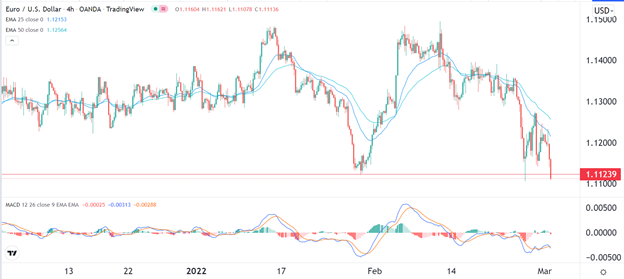Bearish View
- Sell the EUR/USD pair and set a take-profit at 1.1040.
- Add a stop-loss at 1.1160.
- Timeline: 1-2 days.
Bullish View
- Set a buy-stop at 1.1150 and a take-profit at 1.1250.
- Add a stop-loss at 1.1100.
The EUR/USD pair retreated in the overnight session as investors started to predict that the current Russian crisis will push the ECB to slow its tightening. The pair dropped to a low of 1.110, which was lower than Monday’s high of 1.1273.
ECB in Difficult Place
Analysts believe that the ECB is at a difficult place as the crisis in Ukraine escalates. The immediate impact of the crisis on the European economy is on the rising energy prices. The price of crude oil jumped to $105 per barrel for the first time in more than 7 years. Similarly, European gas prices rose to the highest level ever recorded.
The cost of other items is also expected to rise since Russia is being cut-off from the world market. On Tuesday, Maersk and Mediterranean announced that they will halt shipping to and from Russia. This is a notable thing since these are the two biggest shipping companies in the world. As a result, while Russia will be the most hit, other European countries will also suffer.
On Wednesday, Eurostat will publish the latest inflation data from the European Union. Analysts expect these numbers to show that the headline consumer inflation surged to 5.3% in February. Still, these numbers will not have a major impact on the pair since investors already expect that prices will rise in March because of the crisis.
Therefore, the ECB has a balancing act to do. While higher interest rates are needed to slow inflation, more tightening will lead to significant shocks to the economy.
The EUR/USD pair will also react mildly to the latest German unemployment rate data. The numbers are expected to show that the country’s unemployment rate dropped to 5.0% in February. It will also react mildly to the latest estimate of US jobs data by ADP.
EUR/USD Forecast
The EUR/USD pair crossed the important support level at 1.1123 on Tuesday. This was an important point since it was the lowest level in January. It also moved below 1.1100, which was an important psychological level and the lowest point last week.
The pair has dropped below the 25-day and 50-day moving averages while the MACD and the Relative Strength Index (RSI) have pointed downwards. Therefore, by moving below these two support levels, it is a sign that bears have prevailed, meaning that the pair will likely keep falling.


